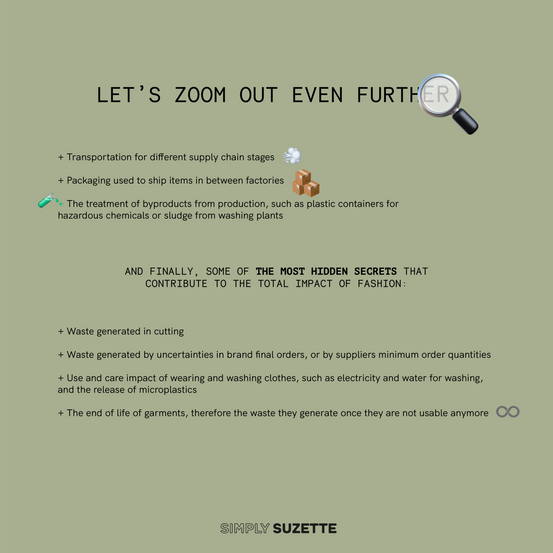Total Impact
- Virginia Rollando

- Mar 1, 2022
- 3 min read
Updated: Mar 22, 2022
Hi readers, if this is your first time here we would like to walk you through the journey that led us to writing this article. We started the year talking about COP26 and the impact of fashion on climate change. We then discussed the different options to reduce the impact that Fashion has through the use of alternative energy sources, and recently published two articles explaining what LCAs are, how they can be useful tools to understand where to act, and what their limitations are. All these articles cover environmental impact from different angles, however we thought that it would be useful to take a step back and answer the question: what is the total environmental impact of a product or company?
TOTAL IMPACT IN SUPPLY CHAINS
Think of a pair of jeans. There are impacts that are clearly part of the impact:
Cotton and other fibres
Metal Trims
Dyes
Electricity for spinning, weaving, dyeing
Steam and water for washing
What else is there?
Packaging materials
Shipping emissions
Waste from all the samples that are manufactured and never used The impact of factory buildings, beyond just machinery, such as lighting, air conditioning, waste water treatment
That’s it, right? Not quite. Let’s zoom out even further:
Transportation for different supply chain stages
Packaging used to ship items in between factories
The treatment of byproducts from production, such as plastic containers for hazardous chemicals or sludge from washing plants
And finally, some of the most hidden secrets that contribute to the total impact of fashion
Waste generated in cutting
Waste generated by uncertainties in brand final orders, or by suppliers minimum order quantities
Use and care impact of wearing and washing clothes, such as electricity and water for washing, and the release of microplastics
The end of life of garments, therefore the waste they generate once they are not usable anymore.
Some terrifying information came out recently about the clothes dump in Chile’s Atacama desert, but where is this conversation in glossy sustainability marketing campaigns that we see on brand’s websites and shops?
THE SUSTAINABILITY OF A GARMENT IS DEFINED BY ITS LEAST SUSTAINABLE ASPECT.
Advertising that one specificity of it is sustainable, such as being partially made by recycled content, and ignoring its total impact, which could include hazardous chemicals, is not fair advertising.
TOTAL IMPACT FOR COMPANIES
Another issue related to the concept of total impact is the difference between a company’s total emissions and those of a single product.
Think of a pair of jeans. A company that is trying to reduce its environmental impact will try to reduce the impact of that specific product. However, what matters for the planet and people is the total emissions generated by all products combined.
This is why there is a difference between product LCA and corporate LCAs and brands that release sustainable capsules versus embedding sustainable practices within their entire business. Corporate LCAs assess an organisation’s entire footprint, including things such as transportation or employee waste.
Reducing the impact of specific products by 30% , but having growth strategies to achieve a 50% increase in production is environmentally destructive.
CLIMATE CHANGE IS NOT DRIVEN BY SINGLE IMPACT, BUT BY TOTAL IMPACT.
Companies that have the commitment to reduce the impact of specific products through material substitution, or using renewable energy, but then encourage their customers to increase their buying frequency, end up causing more damage than good to the planet. Of course this is linked to a very large capitalistic system which requires constant buying and growth.
But as J. B. MacKinnon, author of “The Day The World Stops Shopping,” told us in conversation, there are so many well known economists that have all pointed towards an economic goal of accumulating enough wealth so that we can set aside the pursuit of things and money. Clearly, we have lost sight of that goal in our pursuit for more and more.
Total impact is very important to understand why truly committed companies are embracing the concept of degrowth.
Stay tuned for the next article in which we will analyse different degrowth strategies, interview J. B. MacKinnon, author of “The Day The World Stops Shopping,” and how we believe these concepts and strategies can be put into practice!
Until next time friends, always be curious and stay diligent!















Comments